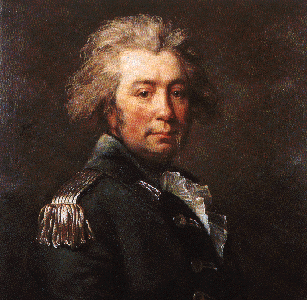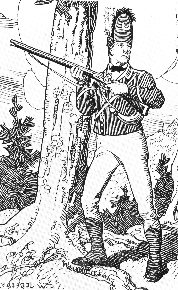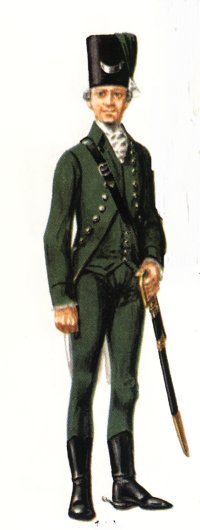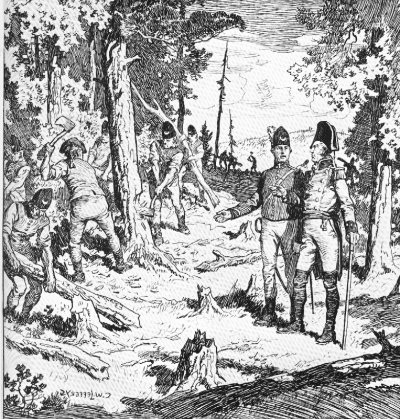
foreword | Historical Narratives | Resources | Links | Contact
THE QUEEN'S RANGERS
History shapes the world we which we live.
Lieutenant Governor Simcoe asserted
In His Own Words"I am most anxious to be the Chief of these troops so that I may adapt their tactics and discipline to the country." By 'these troops,' Simcoe was referring to the Queen's Rangers, a corps revived by him to develop and defend Upper Canada.
 |
|
Queen's Ranger |
The original 1st American Regiment or Queen's Rangers, a Loyalist unit, was among the very finest units serving during the American Revolution. As dashing mounted troops as ever served the crown, the Rangers, a carefully selected group of men trained for special operations, served with great distinction under Simcoe, who took command of them in 1777 with the rank of major and brought them up to a high state of efficiency. The regiment consisted of eleven infantry companies, comprising one grenadier, eight battalion, one light and one Highland company, the latter wearing a kilt and carrying the bagpipes. The corps included one squadron of hussars,[See Below *] three squadrons of light dragoons, [**] and one light cannon. The light dragoons were specially organized for rapid movement and skirmishing. This corps unlike other Loyalist units which after 1778 changed to red coats, the Rangers always wore green in order to be less conspicuous and more suitable for light troops.
Simcoe expected the following advertisement to all loyal and gallant subjects would quickly add to the effective strength of his Hussars.
"All Aspiring Heroes have now an opportunity of distinguishing themselves by joining The Queen's Rangers HussarsAny spirited young man will receive every encouragement, be immediately mounted on an elegant horse, and furnished with clothing, accoutrements, etc. to the amount of Forty Guineas, by applying to Cornet Spencer at Hewitt's Tavern." Vivant Rex et Regina
 |
|
John Graves Simcoe |
Simcoe paid for the advertisement and for outfitting the new recruits. The Queen's Rangers were almost exclusively at the command of their commanding officer, and were expected to be ready to strike a blow whenever they were needed, no matter how hazardous the enterprise. The troops, including the excellent light cavalry, wore green for camouflage. The most important duties of this corps were "those of vigilance, activity and patience of fatigue and were best learned in the field." Frequently, the Queen's Rangers Hussars were used to charge and disperse sniping parties.
 |
The Rangers were skilled in ambuscade, just the kind of corps suited to a country of wood and stream in which they always endeavoured to make pitfalls for the enemy. They were quick in action, vigilant in their duties and courageous. During the course of a week, the infantry would often march ninety mile and the Hussars travel a good deal further. They were often cited in orders for their "spirited and gallant behaviour."
Simcoe emphasized training for rapid, skillful skirmishing, a commando-type combat suited for forest and stream. They were especially competent in the use of the bayonet on which they placed heavy reliance. It was proudly claimed of the Queen's Rangers that "no sentinel was ever surprised." The regiment was among those included in General Cornwallis's surrender on 19th October, 1781. Because they were largely Loyalists, Simcoe requested Cornwallis to allow them to disperse before surrendering because he feared the Americans would treat them harshly. Cornwallis refused. Like other regiments raised during the American war, the Queen's Rangers Regiment was disbanded after the revolution and many of the men settled in Nova Scotia.
Following his appointment as lieutenant governor of Upper Canada, Simcoe sought to restore the regiment to service in the colony, but for a role unlike that of the original Rangers. In a letter written in September, 1791, Henry Dundas, Secretary of State, explained that the Queen's Rangers, in addition to helping defend the new colony against American attack, would also
In His Own Words"assist in making the roads of communication between the different parts of the province, in building bridges, erecting barracks, clearing lands, navigating craft - in short assisting with any military or civil service."
The Queen's Rangers Regiment was dispatched to Upper Canada where it occupied the barracks at Newark. The corps was to be trained in the kind of guerilla shoot and scoot-type warfare "in which the Indians excel." They were to be totally free of garrison duties, for more important than their military mandate, was the primary function of promoting the Civil Establishment by creating an infrastructure for Upper Canada. While they were to defend as well as develop Upper Canada, the emphasis was to be on development.
It addition to labouring, the soldiers were to learn. It was Simcoe's intention to educate the troops in various occupations useful to the community. This was to take place in a regimental school where the men would receive learning "sufficient for their station" to train them to become useful citizens.
The soldiers were to spend two days a week on public works, two on military exercises and two for their "private advantage, such as clearing land for pay." In this way Simcoe intended each soldier to supplement his earnings and so
In His Own Words"acquire the Habit of Industry to keep him from becoming a burthen to the community."
The War Office opposed the creation of Simcoe's corps of Queen's Rangers because it reduced the complement of troops available for regular military duty. Nevertheless, the King approved the corps, but instead of the ten companies Simcoe requested, he received only four with a complement of 400 officers and men. Queen's Ranger recruits had to be at least five feet four and one-half inches in height, healthy, husky, and not under 16 nor over 30 years of age. Discharge from the corps was permitted after only five years' service, providing a substitute was found and the departing soldier agreed to serve in the local militia.
Simcoe wanted the soldiers "accoutered for concealment" and so insisted on green as the colour of their uniform. If a green uniform were put on in the spring, he said, "by autumn it nearly fades with the leaves and is scarcely discernible at a distance." Accordingly the King authorized the regiment to be "clothed in green with blue cuff and collar bordered with white lace." [***]Breeches were white and the headgear a brimless cap decorated with the crescent badge worn by the original Rangers.
 |
|
Queen's Ranger |
The Queen's Rangers were hutted in 28 log barracks built by them at great exertion at the Lower Landing or Queenstown during the winter of 1792-93. An oven was constructed so they could bake their own bread. It was not long before the recurring sickness of the soldiers convinced Simcoe that the barracks on the banks of the Niagara River were in a very unhealthy location, largely because of the thick fog or miasma that frequently rose from the river. It was thought this miasma was responsible for the settlement periodically suffering from outbreaks of "fever and ague," a disease now known as malaria. Simcoe considered York a healthier location,and he was anxious to hut the troops there before "they are all buried." He was right for when the soldiers had relocated across the lake they quickly recovered. The Rangers felled great oak trees for their log barracks built on the site of Fort York. Work was slow and difficult and until the barracks were constructed, the men were forced to shelter themselves in bowers made of branches.
To the consternation of residents in the small communities that gradually grew up about the province, Simcoe showed little interest in using the Rangers to make and maintain roads for the settlers' convenience. He expected the settlers themselves to carry out these responsibilities when time permitted. Because the colony was dependent entirely on water transport, Simcoe was anxious to open up military roads and he used the Rangers to construct these strategic military routes. He pursued his dream of a road, which he named Dundas Street, that would stretch from Burlington Bay to the River Tranche,(which he renamed the Thames) and the future site of Simcoe's proposed capital city, Georgina (which he renamed London.). He placed a high priority on this road. However, because settlement at this time was sparce in what was considered this extreme western end of the province, Simcoe's critics called it a road that ran "from nowhere to nowhere." It turned out to be of major importance and its value was quickly recognized when war broke out with the United States.
 |
|
Queen's Rangers Road Building |
By February 1796 the Rangers had also extended a road, which Simcoe named Yonge Street, as far north as the Holland River. In much of his road-building, defence not commerce was on Simcoe's mind. At a time of high tension with the Americans, Simcoe envisioned Yonge Street as a military link between Lake Ontario and Lake Huron, and he assigned to the Queen's Rangers the task of surveying and starting construction on this road between York and Lake Simcoe which Simcoe named in commemoration of his father. By early 1796 the soldiers had extended the road as far as Holland Landing. Rangers also constructed the blockhouse, storehouses, barracks and palisade of what is today Fort York.
Upon discharge a Ranger received 50 acres of land, the grant intended to motivate men to remain in Upper Canada. For "settling such soldiers of the Rangers as shall be discharged," a block of land was designated in the "Tobicoke" area. In spite of enticements to serve and then settle, desertion from the ranks of the Rangers was a real problem. Simcoe reported from Navy Hall that some deserters had been caught and court-martialled. Many others were more successful, so many, in fact, that by September of 1796 desertions had reached the point where all public and private works were brought to a standstill. The acute shortage of soldiers was aggravated by Lord Dorchester's decision to withdraw two regiments of regular redcoats from Upper Canada. This necessitated their replacement at various garrisons with Queen's Rangers, detachments of which had to be assigned to Fort Miami, Fort George and Fort Erie.
The Queen's Rangers corps was established on 20th of December, 1791 and disbanded on the 10th of June, 1802. The original regiment's 45 cm-square colours were retained by Simcoe after the Revolution and were discovered in the early 1900s hanging in Wolford Lodge, Simcoe's estate in Devon, England. They were purchased by a Canadian businessman, and in 1975 presented to the modern-day Queen's York Rangers, an armoured militia unit in whose Officers' Mess at Fort York they are proudly preserved.
[*] Hussar: A light cavalry soldier
[**]Dragoon: Originally mounted infantry who fought on foot and had inferior mounts. Later they became light cavalry. The name came from 'dragon', the nickname of a musket with which they were armed.
[***] Lace: The term in military usage covers braid and other forms of woven gold and silver thread around button holes.
Copyright © 2013 Website Administrator